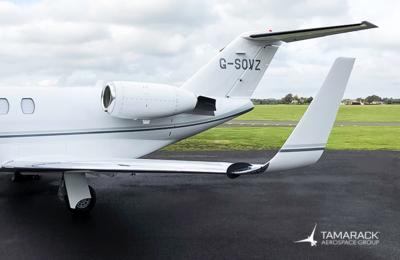Sun, Nov 07, 2021
Says 2018 Citation Crash Report Self-Contradictory
Tamarack has disputed the findings of probable cause in the NTSB’s final report of a 2018 crash of Cessna Citation N525EG.

The Board faulted Tamarack’s Active Winglet system, alleging that the crash was the result of an “asymmetric deployment of the leftwing load alleviation system for undetermined reasons.” Tamarack states that forensic evidence collected in the course of the investigation proved that the load alleviation was indeed functioning correctly and deploying symmetrically upon impact. Additionally, the company points out a number of inconsistencies and omissions in the official report.
First, they note that the NTSB’s final report states the aircraft was rolling at 5 degrees per second, when the autopilot automatically disconnected at 30 degrees of bank, not, as a functioning Citation autopilot would, at 45 degrees of bank or 10 degrees per second. They note the failure of the investigation to account for the premature autopilot disconnect and inappropriate automated response for an excessive bank condition.
Tamarack notes their full cooperation throughout the investigation, but says the NTSB published a revised Factual Report, then the Final Report, without taking into consideration alternative causes.

Their supplemental data paints a picture of target fixation on the part of the agency, as if the concept of an active aerodynamics system was so clearly the cause of the crash that it precluded serious effort into any other avenue. They recall that the Final Report includes information that the pilot was able to carry out some corrective action late in the flight at very high speeds, but fail to make mention that, if there were an active winglet failure, then the aircraft would have been easier to recover at slower speeds. They point to this as a possible lead in understanding the true source of the incident.
They note with sadness the casualties of the accident, and wish to ascertain everything possible that they may prevent future loss of another member of their Citation family.
More News
Its Offerings Are Lighter, Cleaner, and Now Pushing Past 1,000nm on SAF Jet Fuel DeltaHawk’s diesel-powered aircraft lineup has seen incredible upgrades over the last few yea>[...]
The Airplane Experienced A Total Loss Of Engine Power On December 3, 2025, about 1600 central standard time, a Mooney Aircraft Corp. M20K, N57229, was substantially damaged when it>[...]
Make Sure You NEVER Miss A New Story From Aero-News Network Do you ever feel like you never see posts from a certain person or page on Facebook or Instagram? Here’s how you c>[...]
Aero Linx: European Society of Aerospace Medicine (ESAM) As a pan-European, independent forum, it works to promote the safety and health of all persons involved in aviation and spa>[...]
“We are excited to see Wisk achieve this milestone, and I’m so proud of the team that made it possible. The team at Wisk has built advanced technologies across flight c>[...]
 Aero-TV: DeltaHawks Diesel Power Steps Into the Spotlight
Aero-TV: DeltaHawks Diesel Power Steps Into the Spotlight NTSB Prelim: Mooney Aircraft Corp. M20K
NTSB Prelim: Mooney Aircraft Corp. M20K ANN FAQ: Turn On Post Notifications
ANN FAQ: Turn On Post Notifications ANN's Daily Aero-Linx (12.20.25)
ANN's Daily Aero-Linx (12.20.25) Aero-News: Quote of the Day (12.20.25)
Aero-News: Quote of the Day (12.20.25)




